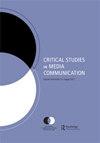The COVID-19 pandemic as a challenge for media and communication studies
IF 1.5
2区 文学
Q3 COMMUNICATION
引用次数: 0
Abstract
and conflict reduction. Based on the continuous popularization of network technology, modern media has become a powerful tool for creating peace. Peace journalists should also pay attention to the discursive power of mainstream media. Ogenga discusses the lack of public discourse in the mainstream print media in Kenya, the original intention of which was to reduce conflicts. In practice, however, it often brings about a surge in confrontation (Chapter 4). The book introduces the case of using the media to intervene in the conflict in Abakuria in Kenya to acknowledge that the media can both achieve peace and provoke conflict. Establishing media that can respond rapidly to changing conditions is often the best practice for media frameworks (Chapter 5). But there are still some problems with the attainment of the ideal of peace journalism beyond those addressed in this book. First, the realization of peace journalism relies on journalists with good morality and peaceful inclinations. It is difficult for journalists to achieve both objective and fair reporting, and the responsibility to speak out for vulnerable people. At the same time, the government or both sides in a conflict will often mobilize powerful media forces to suppress the community influence of peace journalism and to reduce or eliminate its influence on public opinion. Finally, journalists of peace are not necessarily local to conflict areas. If foreign journalists collect media materials in the name of peace journalism, will they be mistrusted and suspected of interfering in the internal politics of high-conflict countries? Human nature, the trade-off of professional ethics, the evaluation of media power, and the avoidance of political and personal risk should be given priority in future research. Only with love for the media profession and ardent desire to resolve conflicts and seek peace can peace journalists truly help the people of East Africa to live peaceful and stable lives.2019冠状病毒病大流行对媒体和传播研究的挑战
减少冲突。基于网络技术的不断普及,现代媒体已经成为创造和平的有力工具。和平记者还应关注主流媒体的话语权。Ogenga讨论了肯尼亚主流印刷媒体缺乏公共话语,其初衷是为了减少冲突。然而,在实践中,它经常带来对抗的激增(第4章)。书中介绍了利用媒体干预肯尼亚阿巴库里亚冲突的案例,以承认媒体既可以实现和平,也可以挑起冲突。建立能够对不断变化的条件做出快速反应的媒体通常是媒体框架的最佳实践(第5章)。但是,在实现和平新闻的理想方面,除了本书所讨论的问题之外,还存在一些问题。首先,和平新闻的实现依赖于具有良好道德和和平倾向的新闻工作者。对于记者来说,既要做到客观公正的报道,又要承担起为弱势群体发声的责任,是很困难的。同时,政府或冲突双方往往会调动强大的媒体力量,压制和平新闻的社区影响力,减少或消除其对舆论的影响。最后,和平记者不一定是冲突地区的当地记者。如果外国记者以和平新闻的名义收集媒体资料,会不会受到不信任,被怀疑干涉高冲突国家的内部政治?人性、职业道德的权衡、媒介权力的评价、政治风险和个人风险的规避等都是未来研究的重点。和平记者只有怀着对媒体事业的热爱,怀着化解冲突、谋求和平的热切愿望,才能真正帮助东非人民过上和平稳定的生活。
本文章由计算机程序翻译,如有差异,请以英文原文为准。
求助全文
约1分钟内获得全文
求助全文
来源期刊

Critical Studies in Media Communication
COMMUNICATION-
CiteScore
2.10
自引率
0.00%
发文量
34
期刊介绍:
Critical Studies in Media Communication (CSMC) is a peer-reviewed publication of the National Communication Association. CSMC publishes original scholarship in mediated and mass communication from a cultural studies and/or critical perspective. It particularly welcomes submissions that enrich debates among various critical traditions, methodological and analytical approaches, and theoretical standpoints. CSMC takes an inclusive view of media and welcomes scholarship on topics such as • media audiences • representations • institutions • digital technologies • social media • gaming • professional practices and ethics • production studies • media history • political economy. CSMC publishes scholarship about media audiences, representations, institutions, technologies, and professional practices. It includes work in history, political economy, critical philosophy, race and feminist theorizing, rhetorical and media criticism, and literary theory. It takes an inclusive view of media, including newspapers, magazines and other forms of print, cable, radio, television, film, and new media technologies such as the Internet.
 求助内容:
求助内容: 应助结果提醒方式:
应助结果提醒方式:


